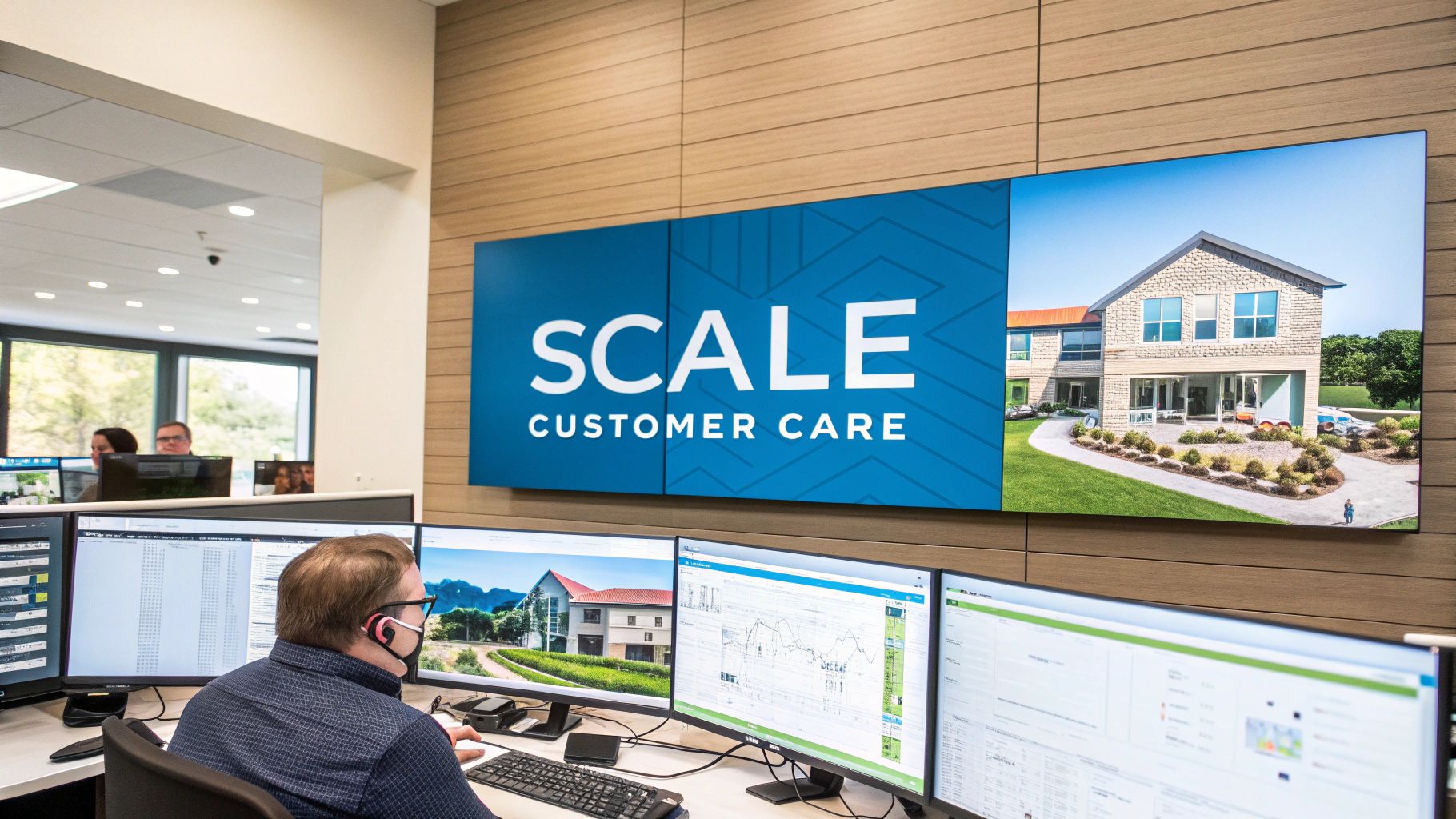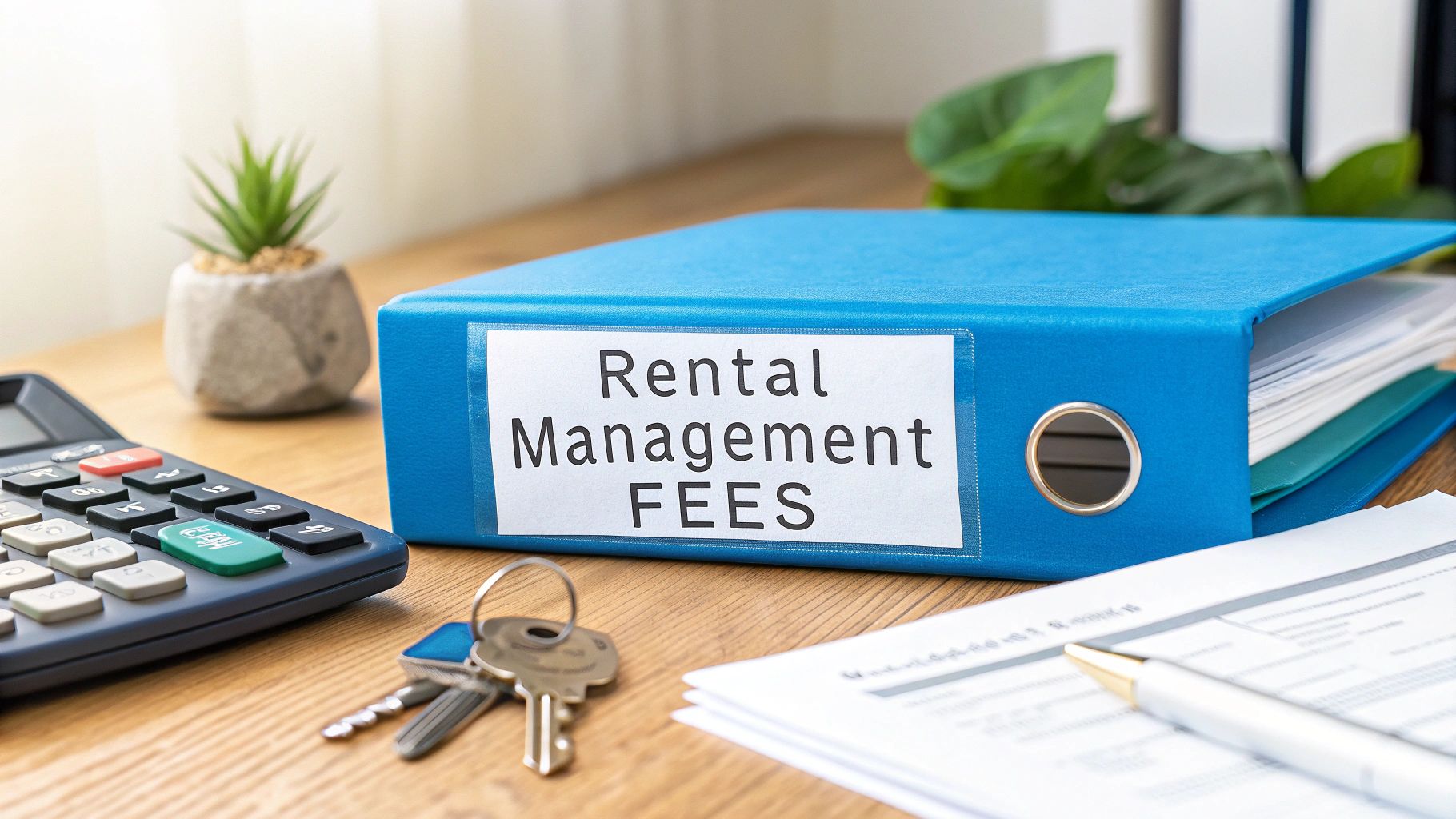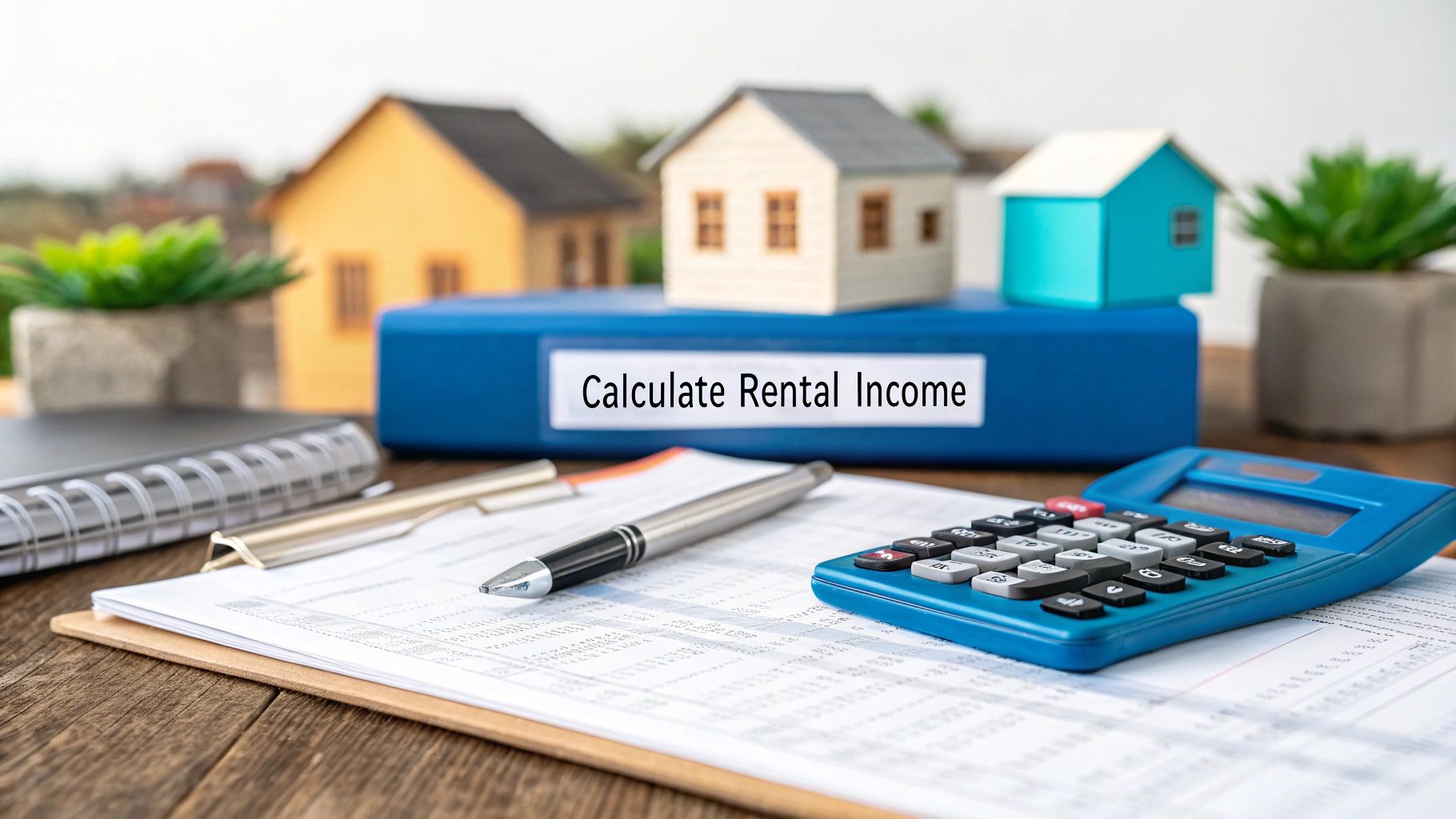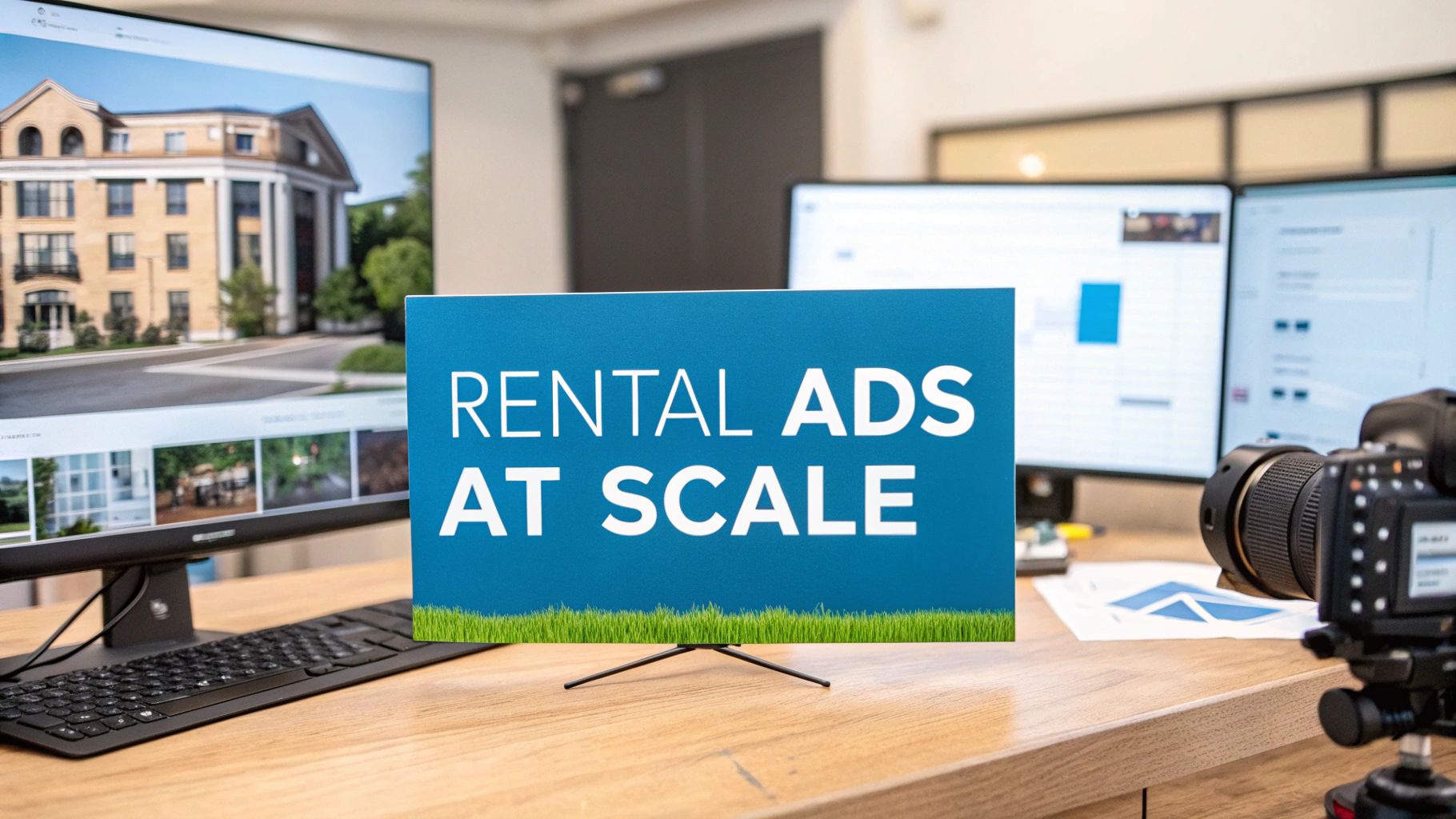For property management companies overseeing 1,000 to 10,000+ units, customer service isn't a soft skill—it’s a critical driver of portfolio revenue. Every day a unit sits vacant directly impacts your bottom line. Scaling service successfully requires a strategic blend of technology, standardized processes, and empowering your remote teams. Get this right, and customer service stops being a cost center and becomes your most powerful tool for reducing Days on Market (DOM) and maximizing profitability.
Redefining Customer Service for Large Scale Portfolios
If you're overseeing 1,000+ units, the old, reactive model of customer service is a recipe for lost income. Simply waiting for issues to arise is wildly inefficient and fails to meet the expectations of today’s renters. To compete at scale, you must shift from firefighting to proactively engineering a customer journey that directly boosts your bottom line.
Think about it: every interaction, from a prospect's initial inquiry to a resident's move-out, is an opportunity to improve key performance indicators (KPIs). When you deliver exceptional, tech-enabled service, you directly influence the metrics that keep operations directors up at night:
- Drastic DOM Reduction: Quick, professional, and automated communication gets high-intent prospects on a tour before they move on to a competitor. This is the fastest path to slashing your Days on Market (DOM).
- Higher Lead-to-Tour Conversion: A frictionless, tech-powered process for tour scheduling means you convert more qualified leads who are ready to sign a lease.
- Improved Tenant Retention: Positive service experiences are the foundation of resident loyalty, which saves you the significant costs associated with unit turnover and vacancy.
The Financial Impact of Scaled Service
Every day a property sits empty, it's a direct hit to your portfolio's revenue. A modern, tech-forward approach to customer service is one of the most effective tools for reducing days on market for your rental properties. By automating routine communications and leveraging platforms for on-demand tour scheduling, you can accelerate the entire lead-to-lease cycle.
DOM Cost Analysis: For a 1,000-unit portfolio with an average rent of $1,800, every day a unit is vacant costs the portfolio $60,000. Cutting just two days off your average DOM adds $120,000 in revenue directly back to your bottom line for every leasing cycle. This is the tangible ROI of investing in scalable service operations.
Embracing a Tech-Enabled Framework
Property management is undergoing a massive digital shift. The industry is projected to surpass $119 billion in revenue by 2025, largely thanks to innovations that improve both customer experience and operational efficiency. Renters now expect instant answers and digital-first communication, putting real pressure on managers to keep up. You can see just how much the market is changing with these insightful property management statistics on resimpli.com.
To thrive in this environment, large-scale operators need an operational framework built on three core pillars. It’s not about just buying software; it’s about building an integrated system that supports your team and your financial goals.
Ultimately, integrating technology, standardizing your playbook, and empowering your people are what turn customer service from a reactive chore into a proactive, revenue-generating machine. This framework is your key to scaling successfully.
Building a Tech-First Service Blueprint for Remote Teams
Managing a multi-state portfolio without onsite staff at every property presents a massive operational challenge. To succeed, you need a practical, tech-driven blueprint designed specifically for remote operations at scale.
The key is to map the entire customer journey—from the moment a prospect clicks an ad to the day a resident moves out—and plug technology into the most critical, revenue-impacting touchpoints. This isn't about adding more software; it's about building a unified, scalable system that turns disconnected tasks into a smooth, efficient operation.
It all starts with standardizing how you handle every single lead.
Standardizing the Prospect Journey
When you're managing a large, distributed portfolio, consistency is the bedrock of efficiency and brand integrity. Your service blueprint must define exactly what happens at every stage of the prospect experience. This ensures every potential renter receives the same prompt, professional service, regardless of which property they’re interested in or which team member handles the inquiry.
You need a system that centralizes all communication and automates repetitive steps. If you want to dig deeper into optimizing for a team that isn't in one office, some great remote call center management strategies can be adapted directly to a remote leasing team.
A scalable leasing blueprint must include:
- Automated Lead Response: Every inquiry receives an instant reply with property details and, most importantly, a link to schedule a tour immediately.
- Centralized On-Demand Scheduling: Use a system like the Showdigs on-demand agent network to offer same-day showings. This is how you convert hot leads before they look elsewhere, directly improving your lead-to-tour conversion rate.
- Seamless System Integration: Your showing platform, CRM, and Property Management System (PMS) must communicate via API. This creates a single source of truth and eliminates manual data entry and operational blind spots.
Mini Case Study: A property management company with a 3,000-unit scattered-site portfolio reduced its average lead response time from hours to under 5 minutes. By integrating their showing platform with their CRM and PMS, they eliminated data silos, gained a complete view of every prospect, and boosted their lead-to-tour conversion rate by over 25%.
Leveraging Technology for Remote Operations
Technology is the engine that enables a small, centralized team to manage a large, geographically dispersed portfolio with precision. This is especially true during the leasing phase, where speed-to-lease is paramount.
On-demand showing platforms are the cornerstone of modern remote management. They provide the flexibility to offer immediate tours across your entire portfolio without the overhead of dedicated leasing agents at every property.
This is what it looks like in practice—a network of on-demand agents ready to be deployed across a wide area, ensuring you always have someone available for a tour.

By tapping into a network like this, property managers can offer tours seven days a week, dramatically increasing their capacity to meet prospect demand and reduce vacancy days. For any property management company serious about cost per door optimization and scaling to 5,000+ units, this tech-first blueprint is essential.
Balancing Automation With a Human Touch
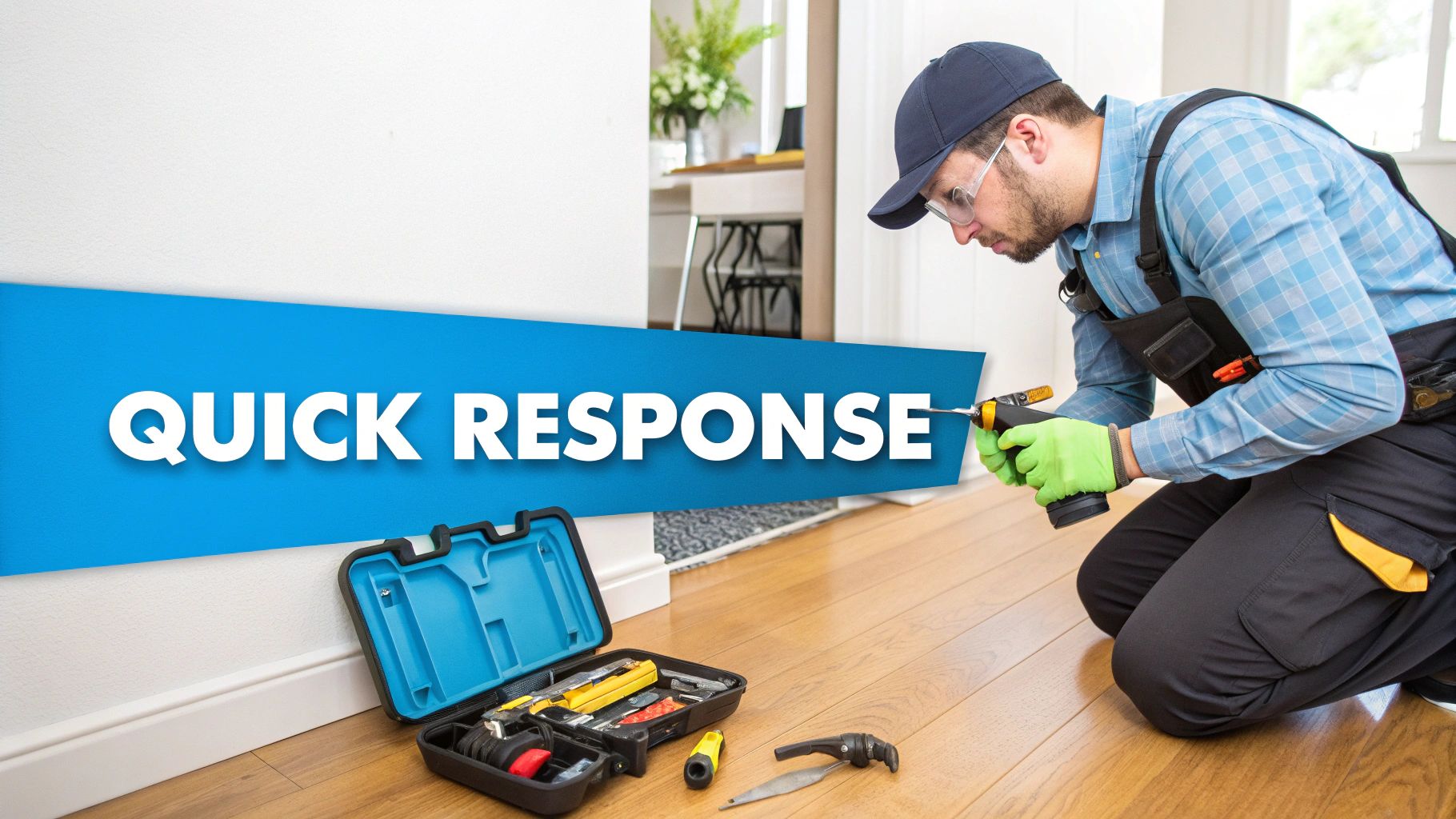
While automation drives efficiency at scale, it’s the human element that builds tenant loyalty and reduces costly turnover. For large portfolios, finding the right balance between the two isn’t just a nice-to-have—it's a massive competitive advantage in property management customer service.
The goal is to automate predictable, high-volume tasks so your skilled team can focus on high-value, complex interactions. This hybrid model frees up your people to handle the exceptions that technology can't touch.
Identifying Tasks for Automation
Certain repetitive tasks are ideal candidates for automation. Implementing technology here creates consistency across a 1,000+ unit portfolio and directly impacts how quickly you can lease a property.
The biggest wins come from automating:
- Initial Lead Qualification & Scheduling: Instantly respond to every inquiry with property details and a link for prospects to book their own showings 24/7. This can dramatically shrink your Days on Market (DOM) by capturing leads the moment they show interest.
- Application & Screening Follow-up: Automate reminders and status updates to keep applicants engaged and moving through the pipeline.
- Routine Resident Communication: Use automated messages for rent reminders and routine announcements. It reduces manual follow-ups and ensures consistent messaging.
This approach lets your team save their energy for what really matters.
Preserving the Human Element Where It Counts
While technology handles the volume, your team delivers the value. Certain situations demand the empathy, nuance, and creative problem-solving that only a person can provide.
The most successful enterprise property management companies don't replace people with tech; they empower their teams with technology, allowing them to focus on activities that drive revenue and build lasting relationships.
Ensure your team is front and center for these critical moments:
- Navigating Complex Tenant Disputes: You can’t automate mediation. Resolving disagreements requires active listening and a human touch.
- Lease Renewal Negotiations: A personal conversation about a tenant's future plans can be the deciding factor between a renewal and a costly vacancy.
- Handling Sensitive Issues: Addressing delicate financial or personal situations with compassion builds trust and long-term loyalty that pays dividends.
There's a significant opportunity for tech-forward PMs. Research shows that only 25% of call centers have fully integrated AI into their operations. This is a big deal, especially when you consider that 76% of employees are more engaged when their leaders show empathy—a trait that directly improves service and reduces staff burnout. You can dig into the complete findings on customer service statistics to see the full picture.
By building a hybrid service model that's both hyper-efficient and deeply personal, you can set a new standard for excellence at scale.
Using Service Metrics to Drive Portfolio Revenue
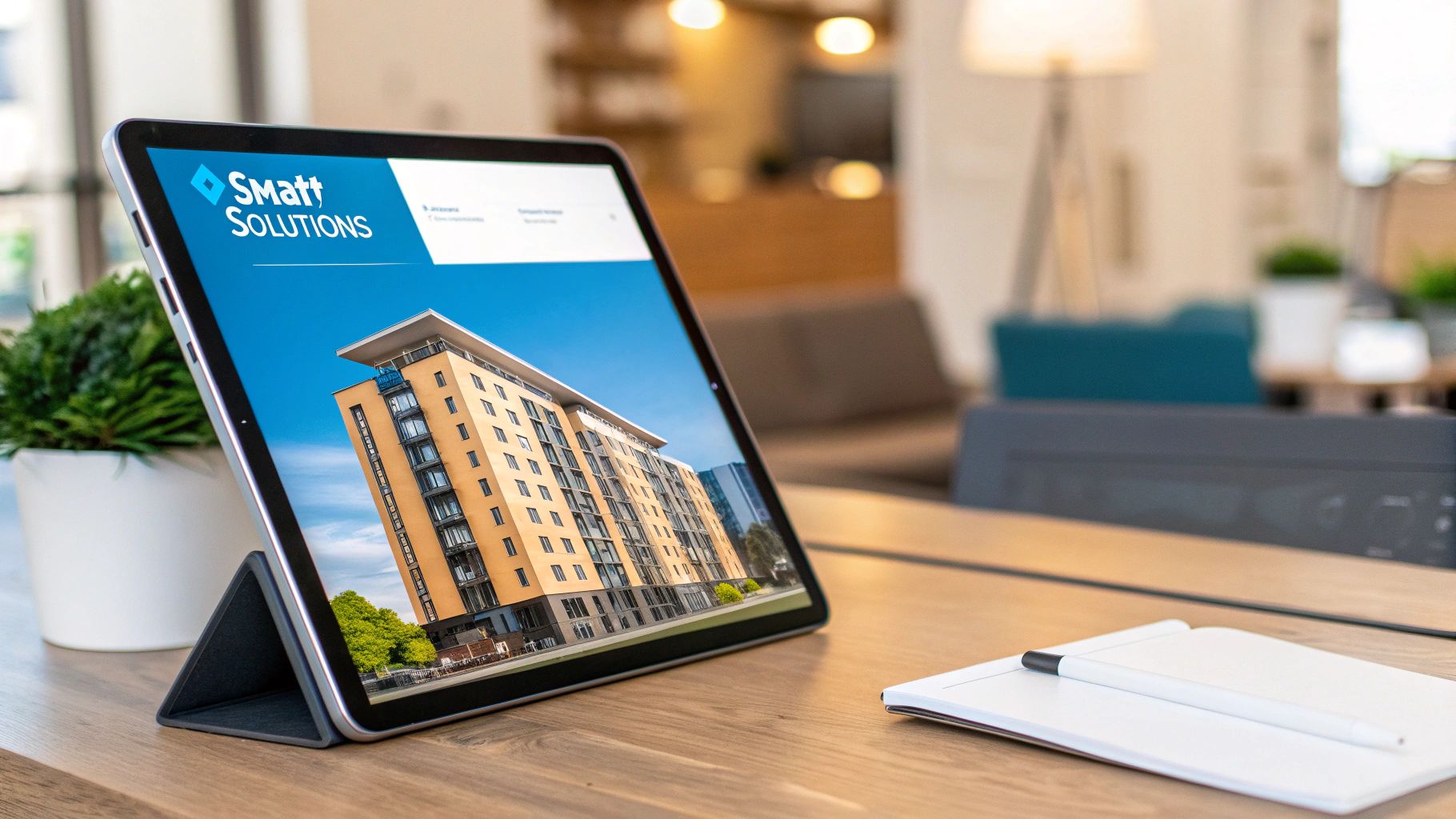
For property managers running large-scale portfolios, property management customer service isn't just a "soft skill"—it’s a data-driven revenue lever. Every single interaction, from the first lead response to a late-night maintenance call, creates data. That data is gold, giving you the insights to optimize your entire operation.
When you start tying service quality directly to financial performance, you can finally move beyond anecdotal wins. It’s about making decisions that measurably impact your bottom line.
This means getting serious about the customer service KPIs that actually matter at scale. These numbers paint a brutally honest picture of your operational health and point directly to opportunities for massive financial gains across your portfolio.
Key Service Metrics for Large Portfolios
While you can track endless data points, a handful of metrics have an outsized impact on the financial health of a large, distributed portfolio. Operations directors should be obsessed with these numbers, as they directly connect service efficiency to profitability.
- Lead Response Time: This is your first impression. A slow response in today's market almost guarantees you’ve lost a hot lead. Track this in minutes, not hours, as it's critical for maximizing your lead-to-tour conversion rate.
- Lead-to-Tour Conversion Rate: This KPI measures how effectively you turn initial interest into a scheduled showing. A low rate is a red flag, often indicating friction in your scheduling process—a problem easily solved with on-demand systems.
- Tenant Satisfaction Scores (CSAT/NPS): Think of these scores as a leading indicator for your renewal rates. A dip in satisfaction is an early warning of impending turnover, which is always more expensive than proactively addressing resident concerns.
- Maintenance Resolution Time: Nothing frustrates a good tenant faster than slow repairs. Tracking the full work order lifecycle—from submission to completion—helps you eliminate the bottlenecks that damage resident relationships and lead to negative reviews.
The Power of One Day: For a 1,000-unit portfolio with an average rent of $2,000, reducing your average vacancy by just one day across all units adds $66,667 in annual revenue. That’s the direct financial impact of a well-oiled service and leasing engine.
Conducting a DOM Cost Analysis
Days on Market (DOM) is more than an operational metric; it's a direct measure of lost revenue. A DOM Cost Analysis is a simple but powerful exercise every large-scale PM should perform quarterly to translate vacancy into hard dollars.
This analysis builds an undeniable business case for investing in service improvements.
The formula is simple:
(Average Rent / 30 Days) x Average DOM x Total Units = Total Vacancy Cost
Running this calculation shows you exactly how much revenue is being lost to vacancy. When you present that number to stakeholders, it becomes clear that tools and strategies for speed-to-lease optimization aren't expenses—they're high-ROI investments.
By systematically improving the key service metrics that influence your DOM, you're actively recovering revenue that was previously lost to inefficiency. To dig deeper, check out our insights on how top-tier property management at scale is achieved.
Your Action Plan for Better Service and Market Position
Strategy without action is just theory. In the world of large-scale portfolios, turning those big ideas into real-world operational changes is what separates the market leaders from everyone else. This is your practical framework for building a modern property management customer service model that doesn't just solve problems but actively drives growth and elevates your reputation.
This roadmap breaks a complex transformation into manageable, scalable steps. The goal is to shift your service from a reactive cost center into a proactive, revenue-driving machine.
First, Nail Down Your Technology and Processes
Before you can improve, you must audit your current tech stack. Where are the operational bottlenecks? Where are the redundancies causing friction for your team and your tenants?
Ask the tough questions: Does our PMS integrate seamlessly with our leasing and maintenance platforms? Where are the data silos preventing us from responding to leads instantly?
Once you identify the gaps, you can select the right tools to build an interconnected ecosystem where information flows freely. This typically includes:
- A centralized CRM to manage every prospect and resident interaction from a single dashboard.
- An automated showing platform like Showdigs to offer on-demand tours that slash your Days on Market (DOM) and boost lead-to-tour conversions.
- A robust resident portal for easy rent payments, maintenance requests, and communication.
With the right tech in place, standardize your processes. Create clear standard operating procedures (SOPs) for critical touchpoints, from initial inquiry to move-out. Then, train your remote team on these SOPs, empowering them with both the tools and the "why" behind the changes. For more on this, check out our guide to effective remote property management operations.
Launch, Track, and Never Stop Improving
Now, launch your new protocols and obsessively track performance. This is where your investment starts paying off. Constantly monitor your KPIs to validate what's working and identify areas for optimization.
This infographic breaks down the essential feedback loop you need to build—one that directly connects your service actions to measurable results.
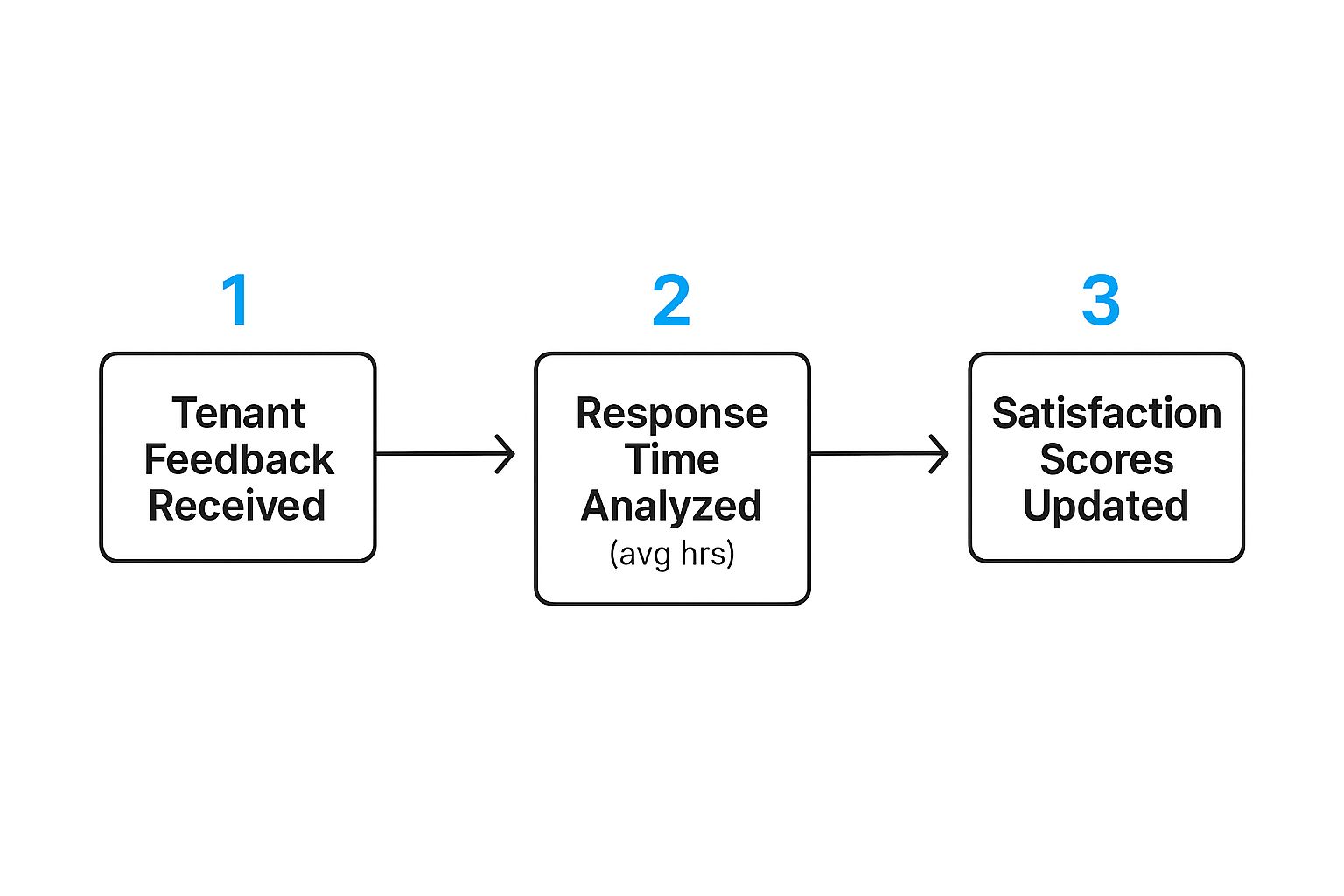
This simple flow—from collecting feedback to analyzing response times and watching satisfaction scores—is the engine of continuous improvement. In a competitive rental market, this is what will set you apart.
The U.S. property management market is expected to hit nearly $98.88 billion by 2029, and we're seeing rent growth pick up in major markets. Superior service is your ticket to attracting and keeping the best tenants in this competitive landscape. You can dive deeper into the numbers by reviewing the full 2025 property management industry report.
Still Have Questions About Scaling Customer Service?
Rolling out new customer service strategies across a large portfolio always raises practical questions. Operations directors at the enterprise level are looking for straightforward answers, not just high-level theory. Let's tackle the most common concerns.
How Do We Get the Team On Board With New Tech?
Change management is often the biggest hurdle. The key is to frame new technology not as a replacement, but as a tool that eliminates their biggest headaches and makes them more effective.
Show them what's in it for them:
- Less Repetitive Work: Demonstrate how automation handles mundane tasks like answering initial lead inquiries or scheduling tours, freeing them up for high-value work.
- Better Work-Life Balance: Explain how on-demand services for showings mean fewer after-hours and weekend interruptions.
- Data-Driven Success: Show how a centralized platform provides the insights they need to close leases faster, directly impacting their performance and potential commissions.
Start with a pilot program. A small group of tech-friendly team members can become powerful internal champions, and their success stories will be your best tool for winning over the rest of the team.
What’s the Real ROI on This Kind of Technology?
Investing in service technology pays for itself by directly improving your most important financial metrics. The ROI is calculated in hard numbers tied to portfolio revenue.
The core of the ROI calculation is vacancy cost reduction. Speeding up the lead-to-lease cycle puts money back into the business that was previously lost to inefficient processes. This is the most compelling argument for any C-suite or owner.
To calculate the ROI, focus on:
- DOM Reduction: Calculate the revenue gained for every day shaved off your average Days on Market. As noted earlier, for a 1,000-unit portfolio, cutting just one day can add over $60,000 in annual revenue.
- Reduced Turnover Costs: Better service leads to more renewals. Calculate the total cost of a single unit turn (marketing, cleaning, repairs) and multiply it by the increase in renewals.
- Improved Team Efficiency: Track the time saved on manual tasks and reallocate it to growth-focused activities, which improves your cost-per-door metric.
How Quickly Will We Actually See Results?
While full adoption takes time, you can see tangible results much faster than you might think. Some improvements have an almost immediate impact.
For example, implementing an on-demand showing service can begin reducing your Days on Market (DOM) and boosting lead-to-tour conversion rates within the first 30 days.
These initial wins create momentum. Focus on high-impact, low-friction changes first. When your team sees early successes, it builds the confidence and enthusiasm needed for the broader operational transformation.
Ready to see how technology can completely change your leasing operations and customer service? Showdigs provides the AI-backed leasing automation and on-demand showing network that helps large portfolios cut DOM, convert more leads, and scale without the chaos. Learn how Showdigs can reduce your vacancy days.




